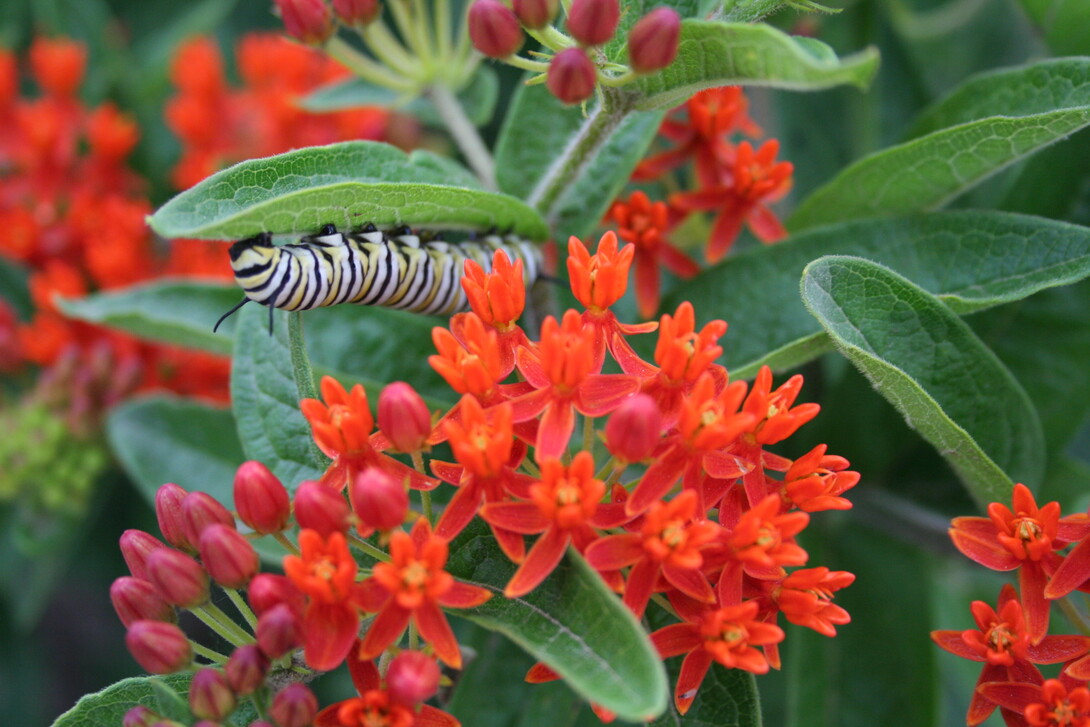
In The Garden — March 2014
Mention pollinators in the landscape, and the first thought of most homeowners is the butterfly. Everyone loves to see this beautiful creature floating on a summer breeze, and some gardeners select plants specifically for them.
Yet it is important to remember there is a long list of pollinators beyond butterflies. A wide range of bees, beetles, moths, flies, ants, birds and even bats all play an important role in pollination. Unfortunately these roles and their effectiveness have diminished in our highly fragmented or entirely altered native ecosystems. Weather changes, heavy use of non-native plants and pesticide use also have contributed to the decline of pollinators.
The most obvious reason this loss matters is that about a third of worldwide food crops are pollinated by the creatures listed above. Closer to home, the productivity of your garden, and of local farms supplying neighborhood markets, is directly affected by the health of the pollinator community. Less obvious but equally (or more) important, pollinators greatly contribute to the complex web of biodiverse ecosystems that support life as we know it.
Of course, as individuals, we can't recreate an entire ecosystem. Yet each of us can contribute our piece of the puzzle and, with participation across the community, the positive impact can be significant. Taking any of the following steps to provide the basics – food, shelter and water – will benefit the pollinators visiting your property.
Grow a diversity of mostly native plants. Many pollinating creatures have evolved in tandem with specific native plants, often creating a high reliance on a single species or limited group. The well-known monarch, a species in alarming decline, is one example. The monarch larvae appear to feed exclusively on plants in the milkweed family. No matter how attractive your non-native ornamental is to you, it may have zero appeal to many pollinators.
The needs of the young of pollinators, like the monarch, are often overlooked. While the adults need nectar and pollen from flowers, the young usually feed on foliage. Though rarely mentioned in pollinator guides, oak and black cherry lead a long list of trees that are important food sources for pollinators. Native goldenrod, asters and the many varieties of native milkweed are some of the most popular herbaceous host plants for pollinators. Even many lawn "weeds," such as clover, plantain and violets, also contribute. Diversity, even in a lawn, is a good thing.
Provide shelter. Pollinators also need shelter for nesting and roosting, plus protection from weather and predators. Of course live plants contribute to this need, but even dead plant materials in various stages of decay are important too. Shelter can be provided with tree snags, rotting logs, leaf litter and stems of annuals and perennials. Or consider creating a bee box or insect hotel (lancaster.unl.edu/nebline/2013/feb13/NebFeb13p01.pdf).
Provide Water. Another easy way to benefit pollinators is to provide a reliable source of water. Bird baths, ponds or even a muddy puddle will do the trick, especially if they have shallow areas with gently sloping sides.
Avoid Pesticides. For the sake of pollinators, it is best to limit or entirely avoid pesticide use. Many pesticides are systemic, meaning they travel to all parts of the plant through its vascular system. This may stop the target pest, but it can also affect pollinators and other beneficial insects, both leaf-feeding larvae and nectar- and pollen-feeding adults, plus insect-feeding bats and birds. (Note: Pesticides for treating the fast-approaching emerald ash borer are systemic.) Surface-applied (contact) pesticides can have similar detrimental effects. Instead, strive for a diverse and balanced landscape with an abundance of beneficial insects to help keep pests in check. Also, accept some insect feeding on your plants and remember that most can tolerate it, unless at extreme levels. Finally, consider organic controls or hand removal of pests.
Sharing our landscapes with pollinators is critical since we have disrupted so many of the native ecosystems. Co-existing with them rather than competing with them will benefit us both. By protecting the interests and needs of pollinators, ultimately we protect our own.
Karma LarsenCommunications Associate
Nebraska Statewide Arboretum
402-472-7923
klarsen1@unl.edu
Dan Moser
IANR News Service
402-472-3030
dmoser3@unl.edu
Click here for larger photo







